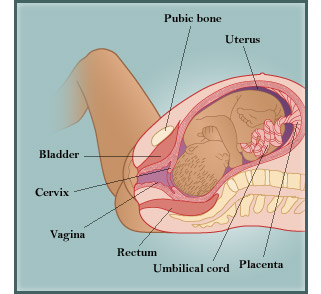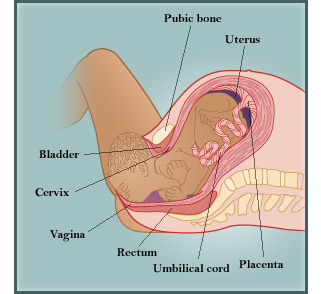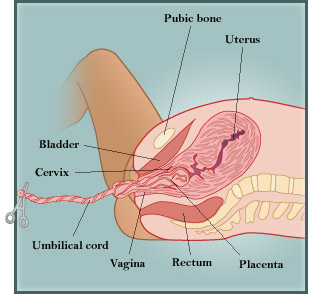Anatomy of Childbirth
When a mother brings a baby into the world, it should
always be a joyous occasion. In developed nations like the United States, it
usually is. But in developing countries, particularly in poor villages far from
proper medical care, childbirth can be fraught with life-threatening hazards.
The World Health Organization estimates that roughly 529,000 women die each
year from problems related to childbirth, and the number of babies that are
stillborn is even higher. In this feature, follow the stages of normal
labor and delivery, and learn about potential problems that can arise as well
as treatments used to cope with them.—Rima Chaddha
Note: This feature is not meant to be comprehensive. For
more complete details on the birthing process, please see the National
Institute of Health's MedlinePlus: Childbirth.
Stage 1: Active labor
Duration: Usually up to 10 hours

The process
Under normal conditions, a mother is pregnant for about
38 weeks before entering labor, the process of delivering her baby. As labor
begins, the mother's body produces large quantities of the hormone
oxytocin, which causes the muscles in her uterus to contract. When contractions
are about five minutes apart and the cervix, the baby's passageway out of
the uterus, has opened to a diameter of about four centimeters (1.5 inches),
the mother has entered what doctors call "active labor." During
this stage, the cervix gradually becomes shorter as it continues to open.
Eventually, it dilates to around 10 centimeters (four inches), which is when
the baby's head begins its descent from the uterus.
Some risks
In some cases, labor can slow down or even stop
completely, especially if the mother is delivering her first child. In the
developing world, where access to adequate medical care is often limited, women
can sometimes be in labor for days. If there is an obstruction—if the
baby is too large to descend through the pelvis or if the mother's cervix
does not open all the way, for example—the baby's head can place so
much pressure on the uterine wall bordering the bladder or rectum that blood
cannot get to that tissue. If it lasts long enough, this pressure can cause the
tissue to die and small holes called fistulas to form. About 9,000 women
develop fistulas each year in Ethiopia alone.
Treatment options
If labor is not progressing normally, doctors or midwives
may intervene to augment or induce labor, sometimes by giving the mother
intravenous synthetic oxytocin or by applying a hormonal gel directly to the
cervix to encourage it to open. Usually the mother's "water"
has already broken—that is, the amniotic sac of fluid surrounding the
baby has ruptured. But if it hasn't, the caregivers may puncture the sac
manually to help the labor progress. In secluded parts of the developing world,
such treatments are often not available, nor is the relatively straightforward
surgery needed to correct fistulas, which could result from inadequate medical
care. (See "Second Chances" for more on
fistula surgery and its enormous benefits.)
Stage 2: Delivery
Duration: 20 minutes to 2 hours

The process
Stage Two begins when the cervix is fully dilated and
ends with the delivery of the baby. At the beginning of this stage, also called
the "pushing stage," the baby's head moves through the
opening of the pelvis. By complying with the natural urge to push, the mother
helps the infant into the world. But if the mother does not experience the need
to push, a possible result of having received an epidural, an injection of
anesthetic to help ease the discomfort of labor, doctors or nurses will coach
her through this process.
Some risks
In developing nations, where many women are physically
small from malnourishment yet whose full-term fetuses may be of normal size,
vaginal birth can sometimes prove all but impossible. Without the option of
cesarean (surgical) birth, a too-small pelvis is likely to result in infant and
sometimes maternal death. Other risks to the infant during both labor and
delivery can include the early detachment of the placenta or damage to the
umbilical cord, which together supply the fetus with its oxygen and nutrients.
Treatment options
Even in developed nations, where nutrition is typically
adequate, some women possess smaller-than-average pelvises. When the fetus is
too large to be delivered vaginally, doctors will perform a cesarean section to
surgically remove the infant from the womb. Cesareans may also be performed if
other complications arise to make vaginal birth too risky. Tragically, such
emergency surgery is often not an option in remote villages in the developing
world.
Stage 3: Post-delivery
Duration: 10-30 minutes

The process
Typically within 15 minutes of the baby's delivery
and after doctors have cut the umbilical cord, the placenta is expelled from the
uterus, usually after a few more pushes from the mother. Since the placenta
developed during pregnancy specifically to deliver nutrients and oxygen to the
baby, the mother no longer needs it.
Some risks
During childbirth, mothers usually lose less than 20
ounces of blood, but women lacking proper medical care will often lose far
more. In fact, postpartum hemorrhage, or excessive bleeding after delivery, is
the leading cause of maternal death in developing countries. The second leading
cause is sepsis, or an infection of the blood, which can occur at any time
during delivery. Altogether, one in every 2,500 mothers worldwide dies each
year of childbirth-related causes. (The developed world sees far fewer deaths;
that figure in the United States, for instance, is one in every 10,000
mothers.)
Treatment options
Studies have found that the hormone oxytocin can aid in
preventing postpartum hemorrhaging. While women produce the chemical naturally,
doctors will sometimes administer synthetic oxytocin as needed. Breastfeeding
also triggers the release of oxytocin—the chemical is associated with
bonding in humans, which helps explain the particularly strong bond between
mothers and their children. Cases of sepsis are rare in developed nations,
where sanitary conditions in hospitals have greatly improved over the past
century. When an infection does occur, a dosage of antibiotics can help fight
it.





